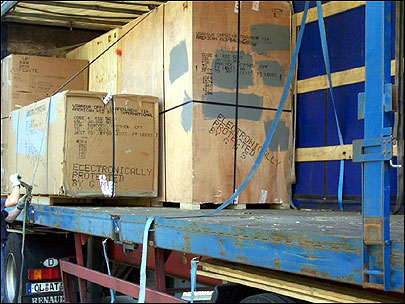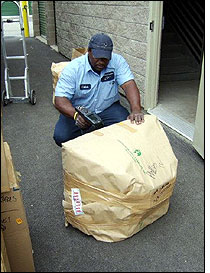The U.S. Department of Defense (DOD) has long been using RFID to tag and track shipments of materiel used by troops. Now, a new project is employing the technology to track the personal belongings of soldiers being moved to new posts overseas.
Having performed successfully during a trial in August, the RFID network is continuing its operation as a live application, with plans to expand the network to other shipping channels. The system tracks personal belongings between two U.S. military bases for the DOD’s Surface Deployment and Distribution Command (SDDC) arm, which manages household goods transportation programs for military service members. Symbol Technologies’ UHF EPC Gen 1 tags are being attached to individual boxes, some items and the plywood shipping crates—known as lift vans—used to transport belongings between Fort Lewis, Wash., and Grafenwohr, Germany.
The trial served as a first test and implementation for the new system, dubbed Global Move Security (GMS). “The trial was to see that the system works, and it does. We had 100 percent read rates for items shipped during the trial,” says Donald Robinson, a spokesman for RFID Decisions, the Seattle-based RFID project consulting and project management firm that developed the trial for household goods forwarder American Red Ball International.
During the trial, several families’ household goods were shipped and tracked in each direction. According to the companies behind GMS, the network will also work effectively for civilian shipments, but the DOD provided an excellent client to start with. “The DOD has an annual budget of about $3.2 billion when it comes to U.S. domestic and international shipping” says Robinson. “That represents more than half the U.S. market.”
The system includes Symbol fixed RFID portals deployed by RFID Global Solution, and handheld interrogators (readers) from data-collection technology provider PSC. As goods are loaded onto a truck at the customer’s pick-up location, shipping agents use handheld interrogators to encode each lift van’s tag with the crate’s ID number, as well as the number given to identify the entire shipment. Those tag details are then uploaded to the Internet-accessible GMS application so shipping parties and customers can access details about the shipment’s location. Customers receive an ID number they can use to log on to an Internet site where that information will be displayed.
As shipments originating in the United States move through the transportation chain, the tags are read again using RFID portals located at Red Ball’s local agent. They are then read again at Orca Moving Systems a port agent in Lakewood, Wash.; at an RFID portal at port agent Express-Transport Shipping Agency (ETSA) in Bremerhaven, Germany; and with handheld readers operated by shipment forwarder Spedition Weilermann at the final destination. Shipments from Germany to the United States are tracked through the transportation chain by means of the same read points, but in the opposite direction.
The ability to track belongings in transit enables shippers to provide customers with detailed information about their possessions’ location, as well as insight into when they will arrive. For the companies involved in the shipping, it also automates the manual process of checking shipments at each stage of the journey.
“[The shipping industry] creates an enormous amount of paperwork and has almost zero automation and data visibility,” says Robinson. There is also the additional security—for both shipping agents and the shipped goods’ owners—of knowing where boxes and even individually tagged high-value items were last tracked. This allows them to determine who is ultimately responsible for any goods stolen or misplaced.
Red Ball’s aim is to offer RFID tracking as a managed service to shipping agents and their military and civilian customers. The next stage will be to expand the military use of the GMS, with the next most-used military routes already being investigated.
The trial grew from an initial investigation by RFID Decisions, on behalf of Red Ball, into the feasibility of tagging Red Ball’s inventory of several million plywood shipping crates in order to better track their location and usage. However, the required investment and the complexity of establishing enough read points to make the system work would not have provided any return on investment, according to Robinson. In the end, the potential for tagging household shipments with the increased customer service and security it provides was considered a far better option.



